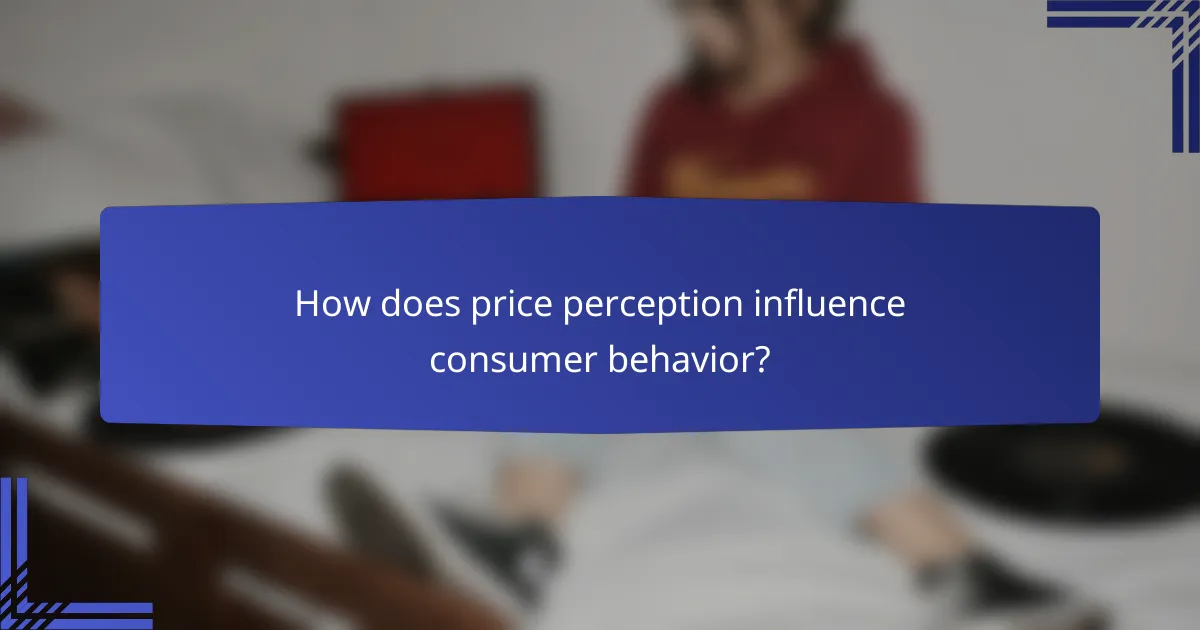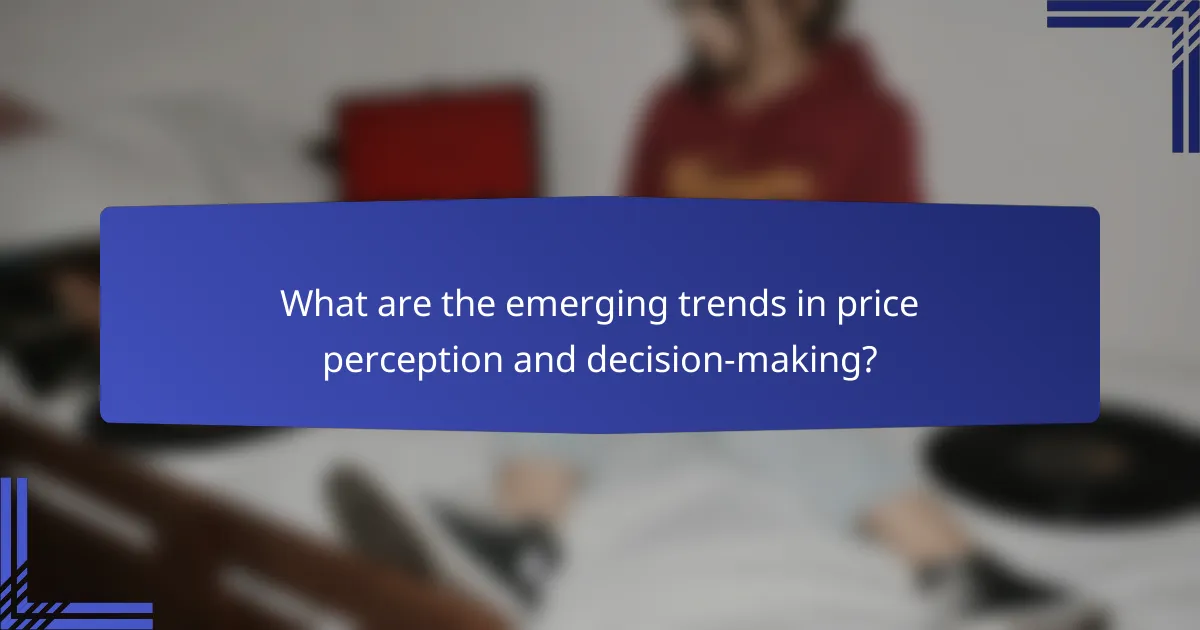Price perception plays a crucial role in consumer behavior, influencing how individuals assess the value of products and services. Higher prices are often linked to superior quality, while lower prices can lead to skepticism regarding reliability. By understanding the factors that shape price value perception, businesses can strategically set prices that resonate with consumer expectations and enhance overall perceived value.

How does price perception influence consumer behavior?
Price perception significantly impacts consumer behavior by shaping how individuals evaluate the value of a product or service. Consumers often associate higher prices with better quality, while lower prices may raise concerns about reliability or effectiveness.
Psychological pricing strategies
Psychological pricing strategies leverage consumer perceptions to influence purchasing decisions. Techniques such as charm pricing, where items are priced just below a round number (e.g., $9.99 instead of $10), can create an illusion of a bargain, prompting consumers to buy. Another approach is prestige pricing, where higher prices are used to signal luxury and exclusivity, appealing to consumers’ desire for status.
Impact of discounts on buying decisions
Discounts can significantly sway buying decisions by creating a sense of urgency and perceived savings. Limited-time offers or flash sales can encourage impulse purchases, as consumers feel they are getting a good deal. However, excessive discounting can lead to price sensitivity, where customers may wait for sales rather than purchasing at regular prices.
Brand reputation and perceived value
Brand reputation plays a crucial role in shaping perceived value and influencing consumer behavior. Established brands often command higher prices due to their reputation for quality and reliability, leading consumers to trust their offerings. Conversely, new or lesser-known brands may struggle to gain traction unless they can effectively communicate their value proposition and build credibility.

What are the key factors affecting price value perception?
Price value perception is influenced by several key factors, including quality signals, market competition, and consumer demographics. Understanding these elements can help businesses set prices that align with consumer expectations and enhance perceived value.
Quality signals in pricing
Quality signals are indicators that suggest the level of quality associated with a product or service based on its price. Higher prices often imply better quality, leading consumers to perceive premium-priced items as more desirable. For instance, luxury brands typically charge more, reinforcing their image of exclusivity and superior craftsmanship.
To leverage quality signals, businesses should ensure that their pricing aligns with the perceived quality of their offerings. Avoid pricing too low, as this can create skepticism about quality. Instead, consider using tiered pricing strategies to differentiate product lines and reinforce quality perceptions.
Market competition and pricing strategies
Market competition significantly impacts price value perception, as consumers often compare prices across similar products. Competitive pricing strategies, such as penetration pricing or price skimming, can influence how consumers perceive value. For example, a company entering a saturated market may set lower prices to attract customers, while established brands might use higher prices to maintain a premium image.
Businesses should regularly analyze competitors’ pricing to ensure their offerings remain attractive. Implementing dynamic pricing strategies can also help adjust prices based on market demand and competition, enhancing perceived value without sacrificing profitability.
Consumer demographics and price sensitivity
Consumer demographics, including age, income, and education level, play a crucial role in price sensitivity and value perception. Younger consumers may prioritize affordability, while older consumers might focus on quality and brand reputation. Understanding these demographic differences allows businesses to tailor their pricing strategies effectively.
To address varying price sensitivities, companies can segment their target market and adjust pricing accordingly. Offering discounts or loyalty programs can appeal to price-sensitive consumers, while premium offerings can attract those willing to pay more for perceived value. Regularly gathering consumer feedback can also help refine pricing strategies to better meet customer expectations.

How can businesses leverage price perception for better sales?
Businesses can enhance sales by strategically managing price perception, which influences how customers view the value of products. By understanding consumer psychology and employing effective pricing strategies, companies can create a favorable impression that drives purchasing decisions.
Effective pricing models for e-commerce
Choosing the right pricing model is crucial for e-commerce success. Common models include cost-plus pricing, competitive pricing, and value-based pricing. Each approach has its advantages; for instance, value-based pricing focuses on the perceived value to the customer rather than just costs.
Consider implementing dynamic pricing, where prices adjust based on demand, competition, or customer behavior. This model can maximize revenue during peak times while remaining competitive during slower periods.
Utilizing customer feedback for pricing adjustments
Customer feedback is invaluable for refining pricing strategies. Regularly collecting insights through surveys or reviews can reveal how customers perceive your prices compared to competitors. This information can guide adjustments to ensure prices align with customer expectations and perceived value.
Be cautious not to rely solely on one source of feedback. Combining qualitative insights with quantitative data can provide a more comprehensive understanding of pricing effectiveness and customer sentiment.
Bundling products to enhance perceived value
Bundling products can significantly enhance perceived value by offering customers a deal that feels more advantageous than purchasing items separately. For example, a tech retailer might bundle a laptop with accessories like a case and software at a reduced price, encouraging customers to buy more.
When creating bundles, ensure that the combined price reflects a meaningful discount compared to individual purchases. This strategy not only increases sales volume but also improves customer satisfaction by providing a sense of savings.

What frameworks help in decision-making regarding pricing?
Several frameworks assist businesses in making informed pricing decisions, focusing on cost structures, perceived value, and market dynamics. Understanding these frameworks can enhance pricing strategies and improve overall profitability.
Cost-plus pricing vs. value-based pricing
Cost-plus pricing involves calculating the total cost of production and adding a markup to determine the final price. This method ensures that all costs are covered but may not reflect the actual value perceived by customers.
In contrast, value-based pricing sets prices based on the perceived value to the customer rather than the cost of production. This approach can lead to higher margins if customers see significant value in the product. For example, luxury brands often use value-based pricing to capitalize on their brand prestige.
Dynamic pricing strategies in e-commerce
Dynamic pricing strategies adjust prices in real-time based on market demand, competition, and customer behavior. This approach is common in e-commerce, where algorithms analyze data to optimize pricing continuously.
For instance, airlines and ride-sharing services frequently change prices based on factors like time of day and booking patterns. Businesses should consider implementing dynamic pricing to maximize revenue, but they must also be cautious of potential customer backlash if prices fluctuate too drastically.

How do cultural differences affect price perception?
Cultural differences significantly influence how consumers perceive prices, impacting their willingness to pay and overall value assessment. Factors such as local customs, economic conditions, and social norms shape these perceptions, leading to variations in pricing strategies across different regions.
Regional pricing strategies in global markets
Businesses often adopt regional pricing strategies to align with local market conditions and consumer expectations. For instance, a luxury brand may set higher prices in affluent areas while offering discounts in price-sensitive markets. This approach helps maximize sales and maintain brand perception across diverse cultures.
Another common strategy is psychological pricing, where prices are set just below a round number, such as $9.99 instead of $10. This tactic can resonate differently across cultures, with some regions responding more favorably to such pricing than others. Understanding local preferences is crucial for effective pricing.
Consumer attitudes towards pricing in different cultures
Consumer attitudes towards pricing can vary widely based on cultural context. In some cultures, high prices are associated with quality and prestige, while in others, affordability may be prioritized. For example, in many Western countries, discounts and promotions are highly valued, whereas in certain Asian markets, consumers may prefer premium pricing as a sign of exclusivity.
Additionally, cultural attitudes towards negotiation can affect price perception. In cultures where haggling is common, consumers may feel empowered to negotiate prices, impacting their overall satisfaction with purchases. Businesses must adapt their pricing strategies to align with these cultural attitudes to enhance customer engagement and loyalty.

What are the emerging trends in price perception and decision-making?
Emerging trends in price perception and decision-making highlight how consumers increasingly value transparency, personalization, and social influence. These factors significantly shape how individuals assess the worth of products and services, leading to more informed purchasing choices.
Transparency in Pricing
Consumers today expect clear and straightforward pricing without hidden fees. Transparency builds trust and encourages loyalty, as customers feel more confident in their purchases. Brands that openly communicate their pricing structures often see higher conversion rates.
For example, subscription services that clearly outline monthly fees and any potential additional costs tend to attract more subscribers than those with ambiguous pricing. Providing a breakdown of costs can enhance perceived value and reduce buyer hesitation.
Personalization of Offers
Personalized pricing strategies are becoming more prevalent, where prices are tailored based on individual consumer behavior and preferences. This approach can lead to higher satisfaction and increased sales, as customers feel that the offers are designed specifically for them.
Retailers can utilize data analytics to segment their audience and deliver targeted promotions. For instance, a customer who frequently purchases fitness gear may receive exclusive discounts on related products, enhancing their shopping experience and encouraging repeat purchases.
Influence of Social Proof
Social proof, such as reviews and testimonials, plays a crucial role in shaping price perception. Consumers are more likely to trust a product that has positive feedback from others, which can justify a higher price point. This trend emphasizes the importance of maintaining a strong online reputation.
Brands can leverage user-generated content and reviews on their websites and social media platforms to enhance credibility. For example, showcasing customer testimonials alongside product pricing can effectively influence potential buyers and increase their willingness to pay.
